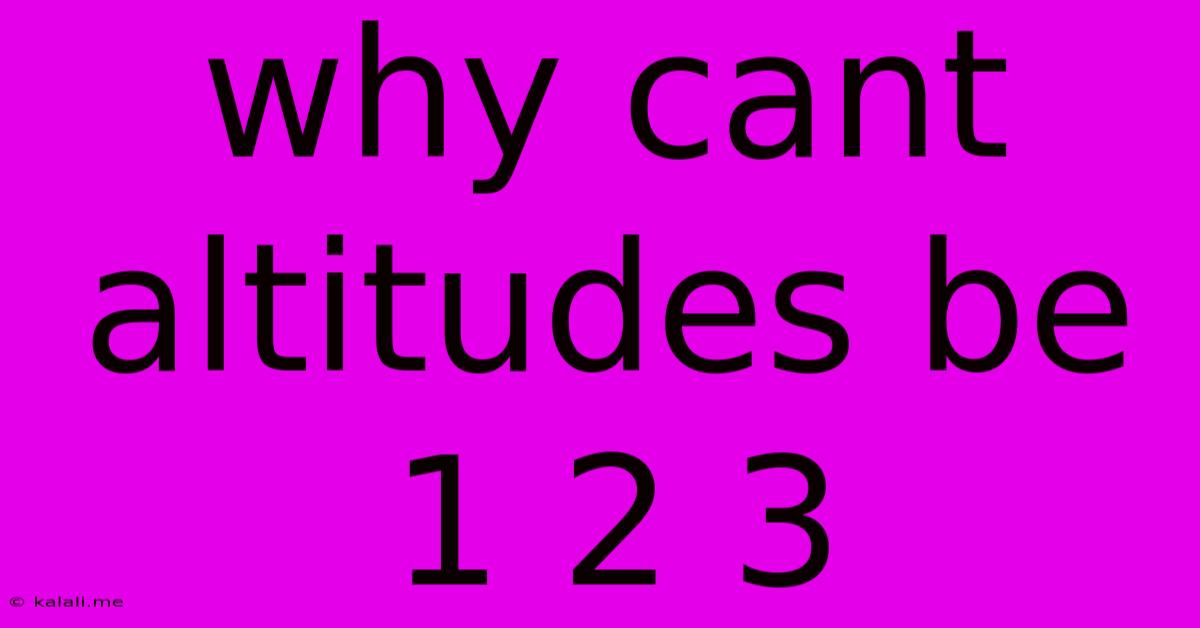Why Cant Altitudes Be 1 2 3
Kalali
Jun 09, 2025 · 3 min read

Table of Contents
Why Can't Altitudes Be 1, 2, or 3? A Deep Dive into Geometric Constraints
Many geometry students, especially those new to proofs and axiomatic systems, often wonder why altitudes in triangles can't sometimes measure 1, 2, or 3 units. The short answer is: it depends on the triangle. There's no universal rule prohibiting altitudes of these lengths; rather, it's a question of the specific triangle's dimensions and properties. This article will explore the reasons behind this misconception and delve into the constraints governing altitude lengths.
Understanding Altitudes
Before we dive into why a specific altitude length might be impossible, let's define what an altitude is. In a triangle, an altitude is a line segment drawn from a vertex perpendicular to the opposite side (or its extension). This opposite side is called the base. The length of the altitude is the perpendicular distance between the vertex and the base.
The length of an altitude is directly related to the area of the triangle. The formula for the area of a triangle is:
Area = (1/2) * base * height (altitude)
Why the misconception about 1, 2, or 3?
The common misconception arises from simplified examples often used in introductory geometry lessons. These examples might focus on right-angled triangles or equilateral triangles with easily calculated areas and altitudes. Students might internalize these examples and incorrectly generalize that altitudes must always be easily calculable whole numbers.
In reality, the altitude of a triangle can be any positive real number. The length is determined by the interplay between the lengths of the sides of the triangle. A triangle with sides of lengths 5, 6, and 7 will have a completely different set of altitude lengths than a triangle with sides of 10, 10, and 10.
Factors Affecting Altitude Length
Several factors determine the length of a triangle's altitude:
-
Side lengths: The lengths of the three sides of the triangle directly impact the possible altitude lengths. Larger side lengths generally lead to larger altitudes (though not always proportionally). The relationship is complex and isn't linearly dependent.
-
Angles: The angles within the triangle profoundly influence the altitude lengths. Acute triangles, obtuse triangles, and right-angled triangles all have different relationships between their sides and altitudes.
-
Area: As mentioned earlier, the area of the triangle is inextricably linked to the altitude. For a given base, a larger area will result in a longer altitude. This means a triangle with a specific area may not be able to have an altitude with length 1, 2, or 3 simply because those lengths aren't compatible with the area and base.
Examples of Triangles with Specific Altitude Lengths
It's perfectly possible to construct triangles with altitudes of 1, 2, or 3 units. However, the other dimensions of the triangle (side lengths, angles) will need to be adjusted accordingly. Consider a triangle with an altitude of 1. If we use a base of length 2, the triangle will have an area of 1 square unit. There are numerous combinations of side lengths that will result in such a triangle.
The key takeaway is that the altitude length isn't independent; it's a consequence of the overall geometric configuration of the triangle. Therefore, while a triangle can have an altitude of 1, 2, or 3, it's not guaranteed, and constructing such a triangle requires carefully selecting the other parameters.
Conclusion
The belief that altitudes cannot be 1, 2, or 3 is a misunderstanding based on limited examples. The length of an altitude is determined by the interplay of the triangle's sides and angles, and it can, in fact, take on any positive real number. The misconception arises from oversimplification in introductory geometrical concepts. The altitude length is just one aspect of a complex relationship within the triangle, emphasizing the rich and multifaceted nature of geometry.
Latest Posts
Latest Posts
-
How Long To Cook Mini Cupcakes
Jun 09, 2025
-
Coolant With No Water Added Jug
Jun 09, 2025
-
Fighting Movie That Is Color Based
Jun 09, 2025
-
Science Fiction Magic Portal In Basement Science
Jun 09, 2025
-
Dot 3 Vs Dot 4 Brake Oil
Jun 09, 2025
Related Post
Thank you for visiting our website which covers about Why Cant Altitudes Be 1 2 3 . We hope the information provided has been useful to you. Feel free to contact us if you have any questions or need further assistance. See you next time and don't miss to bookmark.